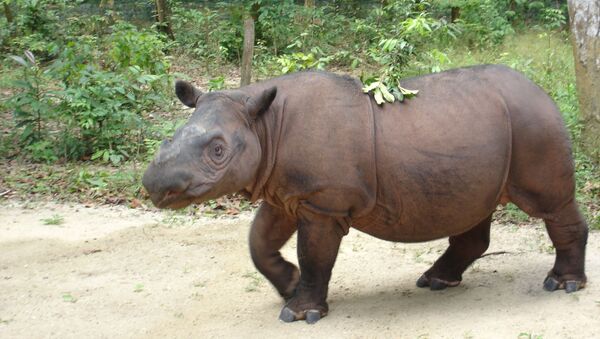Malaysian officials announced Saturday evening that the country’s sole Sumatran rhinoceros had passed away from natural causes related to uterine tumors identified in her bladder several years ago.
“Iman was given the very best care and attention since her capture in March 2014 right up to the moment she passed. No one could have done more,” said Christine Liew, Sabah State’s minister of tourism, culture and environment, as reported by National Geographic.
Liew told the Associated Press that “despite us knowing that this would happen sooner rather than later, we are so very saddened by this news.”
Iman’s death comes not long after the passing of Tam, a male Sumatran rhino that was expected to mate with Iman, but passed away in May of this year. However, Iman’s uterine tumor rendered her unable to conceive and, on top of that, Tam was found to “not have high quality sperm,” according to the International Rhino Foundation.
Malaysia's last Sumatran rhino Iman has died but her memory lives on. pic.twitter.com/Y2v7tcfOw7
— Daily Express Sabah (@DailyExpress_MY) November 23, 2019
According to the foundation, fewer than 80 Sumatran rhinos roam the Earth, and reproduction for this particular species is difficult because, like Iman, the female rhinos are likely to develop cysts and/or tumors in their later life if they do not breed.
While the presence of cysts and/or tumors does not prevent female rhinos from being able to carry offspring in all cases, it does heighten the risk that they will be unable to carry their calves to full term - which takes some 16 months.
The Sumatran rhino has seen population declines of more than 70% in estimates conducted over the past 20 years, noted the International Rhino Foundation. In addition to poaching related to the rhino’s sought-after horn for Asian markets, logging, the development of palm oil plantations and other acts associated with deforestation have contributed to the species’ sharp decline.
Indonesia is the only remaining country with a reported wild Sumatran rhino population - though it numbers only a few dozen.
Despite Malaysia’s now-nonexistent population, biological adversities and man-made obstacles, officials remain hopeful that more can be done to ensure that the Sumatran rhino does not disappear.
“There is limited knowledge about Sumatran rhino reproductive physiology, and converting cells in a laboratory into viable embryos is complex,” Susie Ellis, executive director of the International Rhino Foundation, said in the organization’s release. “Still, there is hope for the survival of Sumatran rhinos.”




